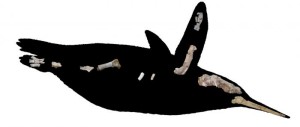March of the Fossil Penguins
Giant five-foot tall penguins? Fearsome, spear-beaked penguins? Flocks of penguins flying through the ancient sky?
There's a lot about the history of these consummately cute birds that most of us don't know. But we can find out as Dr. Dan Ksepka, a paleontologist in the Department of Marine, Earth, and Atmospheric Sciences at NC State, speaks April 6 at the NCSU Libraries.
Penguins have thrived in the southern oceans since the dawn of the Cenozoic Era, more than 60 million years ago. In the past few years, dozens of spectacular new fossils have shed light on the early part of their evolutionary history and revealed a new whole new cast of characters who preceded today's cuties.
Dr. Ksepka' talk, March of the Fossil Penguins: 60 Million Years of Seabird Evolution, will examine the fossil record of Earth's most completely aquatic birds. Drawing on his research trips from South America and New Zealand, Dr. Ksepka will explore how avian paleontologists are trying to answer the question: how did penguins evolve from a flying ancestor to the flightless marine diving birds so familiar to us today?
March of the Fossil Penguins is the latest in the NCSU Libraries' Fabulous Faculty series. It is free to the public, and non-fish refreshments will be served
4 p.m., April 6, 2010
Assembly Room, D. H. Hill Jr. Library
NC State University
Contact: dwhiscoe
(919) 513-3425
